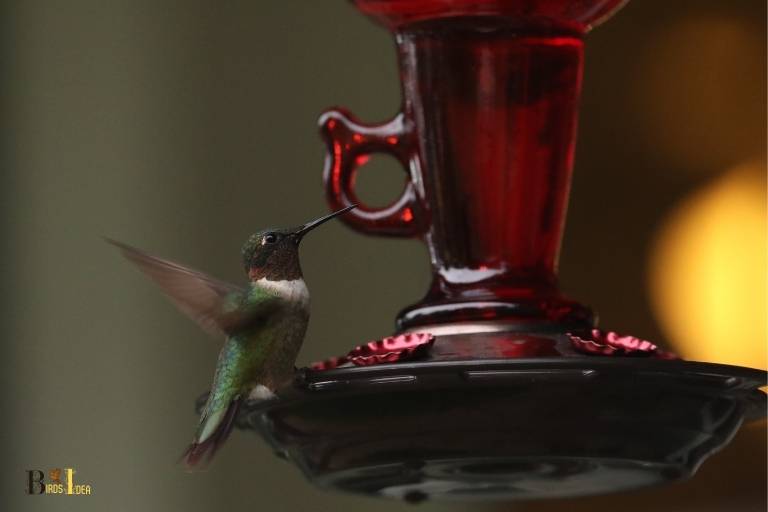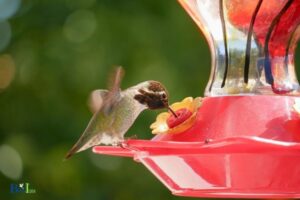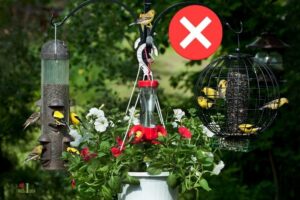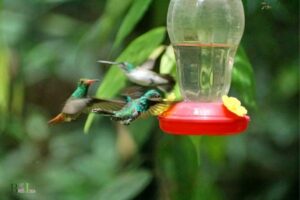What is Attacking My Hummingbird Feeder at Night: Bats!
Raccoons, bats, and flying squirrels are the common nocturnal creatures that often attack hummingbird feeders at night.
At night, while hummingbirds are resting, other creatures may be attracted to the sweet nectar in hummingbird feeders.
The high sugar content of nectar is a source of nourishment for these nocturnal animals, which are known to be adept climbers and flyers, making it easy for them to reach the feeders.
Lastly, placing your feeders in locations such as hanging them from tree branches or using shepherd hooks can make it more challenging for these creatures to access the feeders while still being accessible to hummingbirds during daylight hours.
7 Potential Nighttime Threats to Your Hummingbird Feeder
| Attacker | Description | Damage to Feeder | Prevention Measures |
| Raccoons | Nocturnal animals with a strong sense of curiosity | Knocking over, spilling | Secure feeder, use raccoon baffles, bring feeder inside |
| Opossums | Nocturnal marsupials native to North America | Drinking nectar, spilling | Hang feeder out of reach, bring feeder inside |
| Rats | Small nocturnal rodents | Chewing, spilling | Hang feeder out of reach, use rodent baffles |
| Bats | Nocturnal flying mammals feeding on nectar | Drinking nectar | Hang feeder out of reach, use bat deterrents |
| Mice | Small nocturnal rodents | Chewing, spilling | Hang feeder out of reach, use rodent baffles |
| Ants | Social insects that are attracted to sugar | Crawling inside, contamination | Use ant moats, apply petroleum jelly on hanger |
| Squirrels | Diurnal rodents, but can be active at dawn or dusk | Chewing, spilling | Hang feeder out of reach, use squirrel baffles |
Key Takeaway

Five Facts About: Nighttime Threats to Hummingbird Feeders
Understanding The Problem: What Is Attacking My Hummingbird Feeder At Night?
Brief Explanation Of The Problem
Hummingbirds are highly valued for their beauty, unique behavior, and role in pollination. Hummingbird lovers often put hummingbird feeders in their yards to attract these tiny birds.
However, when you have a hummingbird feeder, you may notice some visitors that you didn’t invite.
These unwanted guests often attack your hummingbird feeder at night, draining the nectar and damaging the feeder itself. Understanding what is attacking your hummingbird feeder at night is crucial to protect the birds and keep them coming to your yard.
Importance Of The Problem For Hummingbird Lovers
The persistent attack on hummingbird feeders at night is a common problem that concerns many hummingbird lovers. It can cause significant damage to the feeders and prevent the hummingbirds from getting the nourishment they need.
If left unaddressed, the problem can escalate and pose a threat to the hummingbirds’ health and survival.
Therefore, it’s critical to identify the attacker and take the necessary steps to deter them.
Overview Of The Article Outline
The following article will provide comprehensive information on the problem of nocturnal attackers of hummingbird feeders.
The article will cover the following topics:
- Identifying the nocturnal attacker: This section will explore the different types of animals that may attack hummingbird feeders at night.
- Understanding the behavior of nocturnal attackers: This section will provide insights into the behavior and habits of the animals that attack hummingbird feeders at night.
- Ways to deter nocturnal attackers: This section will offer various methods to discourage the nocturnal attackers, such as repellents, deterrents, and alternative food sources.
- Preventing attracting the wrong animals: This section will provide tips on how to prevent attracting the nocturnal attackers in the first place.
- A brief summary of the article’s highlights and a final word of caution to hummingbird lovers.
If you want to protect your hummingbirds and their feeders, it’s essential to understand the problem of nocturnal attackers. Identifying the attacker, understanding their behavior and habits, and taking preventative measures can go a long way in keeping your hummingbirds safe and healthy.
Nocturnal Animals That Freqeuently Attack Hummingbirds
Hummingbirds are a delightful sight to see flitting around your garden or backyard. They are tiny creatures with iridescent feathers and an insatiable appetite for nectar.
So, it’s no surprise that many homeowners hang hummingbird feeders to attract them. However, it’s not just these colorful birds that get attracted to the sweet liquid inside the feeders.
Some nocturnal animals also frequent them but not with such good intentions.
Explanation On What A Nocturnal Animal Is
Nocturnal animals are creatures that are active during the night and tend to rest during the day.
They have special adaptations that allow them to see, hunt and move in the dark. These animals have excellent night vision, hearing, and sense of smell, enabling them to find food and avoid predators.
Brief Information About Animals That Attack Hummingbirds At Night
Many nocturnal animals attack hummingbirds at night, but the most common culprits are owls, bats, and raccoons.
Here’s some brief information on each of them:
- Owls: These birds are stealthy hunters that can fly almost silently. They have sharp talons and a strong beak that help them catch and kill their prey. Owls have a varied diet, and hummingbirds make an easy target because they are slow-moving and brightly colored.
- Bats: These flying mammals also have a sweet tooth and love to drink nectar. In fact, some species are pollinators themselves, like the lesser long-nosed bat. Bats have sharp teeth and long tongues that help them feed on nectar, but they may damage the hummingbird feeders in the process.
- Raccoons: These small mammals have nimble fingers that allow them to dismantle bird feeders with ease. They are scavengers that will eat almost anything, including hummingbirds and their eggs.
Possible Ways To Identify The Culprits
Identifying the culprit behind the attack on your hummingbird feeder can be a bit tricky, but there are some ways to figure out what’s going on:
- Look for signs of damage: If your feeder appears to have been broken or knocked over, it’s likely that a larger animal like a raccoon or bear is the culprit.
- Check for footprints: If you see paw prints near the feeder, it’s definitely a mammal that has been visiting.
- Hang the feeder higher: If you hang it higher, it will be harder for raccoons and other animals to reach it.
- Install a motion-sensor light: This can help deter creatures that hunt at night.
Understanding what nocturnal animals frequently attack hummingbirds will help you to better protect your feathered friends. By knowing what to look for, you can take steps to safeguard your feeders and keep these beautiful birds safe.
Insects That May Attack Hummingbirds At Night
Explanation On How Insects May Attack Hummingbirds At Night
Hummingbirds are not only threatened by predators during the day but also face risks at night. At night, insects can be a significant threat to hummingbirds that feed at night or leave their feeders overnight.
The insects can be attracted to the sugary solution in hummingbird feeders, leading to an attack on the hummingbirds.
These attacks can be severe, causing severe damage to the hummingbirds’ wings or body.
Brief Information About Insects That Feed On Hummingbirds (Such As Moths And Praying Mantises) And Their Behavior At Night
Insects that feed on hummingbirds include moths and praying mantises. Moths have long tongues that allow them to reach the bottom of a hummingbird feeder and sip the sugary nectar.
Praying mantises are predatory insects that are attracted to hummingbirds’ motion and color.
They use their sharp front legs to capture and kill prey. The attack can be swift, causing instant death or severe damage to the hummingbird’s wings or body.
Possible Ways To Identify The Culprits
To identify the culprits behind the attack, you can use the following ways:
- Observe the feeders at night. This will help you to see if any insects are feeding on the nectar or attacking the hummingbirds.
- Check the feeders for evidence of damage caused by insects.
- Look for dead insects near the feeders and around the area where the hummingbirds feed.
- Identify the type of insects present using pictures or descriptions online. This will help you find practical solutions to prevent the attacks.
Understanding how insects can attack hummingbirds at night is essential in safeguarding the tiny birds’ lives. By identifying the culprits, you can take practical steps to prevent attacks, including changing the feeder’s location, using insect-proof barriers, or changing the nectar’s formula.
Remember to keep a close eye on your hummingbirds, day and night, to keep them safe from predators.
Physical Evidence Of A Predator At The Feeder
Description Of Physical Evidence That May Indicate A Predator Attack (Such As Feathers, Droppings, And Broken Parts Of The Feeder)
Attacks on hummingbird feeders by predators can leave behind physical evidence that can help identify the culprits.
The following are some indicators of a predator attack:
- Feathers: Feathers found on the ground near the feeder can indicate the type of predator. For example, large feathers may indicate an attack by a larger bird such as an owl or hawk, while small feathers may indicate a smaller bird or mammal such as a cat.
- Droppings: Predator droppings near the feeder can indicate the type of predator. For example, large droppings with bones or fur may indicate a mammal such as a raccoon or opossum, while a sticky or messy dropping may indicate a bird such as an owl or hawk.
- Broken parts of the feeder: Damage to the feeder can indicate the type of predator. For example, deep scratches or holes can indicate a mammal, while dents or breakage can suggest a bird attack.
Tips On Collecting Physical Evidence
Collecting physical evidence of predators attacking a hummingbird feeder can help identify the culprit.
Here are some tips on how to collect physical evidence:
- Use gloves: Wear gloves while collecting evidence to avoid contaminating the evidence.
- Use a plastic bag: Place the evidence in a plastic bag to keep it dry and prevent it from getting contaminated.
- Take pictures: Take pictures of the evidence to document the type and quantity of evidence found.
- Store evidence in a cool, dry place: Store the evidence in a cool, dry place until it can be analyzed.
How To Relate Physical Evidence To The Potential Culprits Mentioned In The Previous Section
Physical evidence can help identify the potential culprits who may be attacking the hummingbird feeder.
Here are some ways to relate physical evidence to the potential culprits:
- Feathers: Use a field guide or online resources to identify the type of bird based on the feathers found.
- Droppings: Use a field guide or online resources to identify the type of predator based on the droppings found.
- Broken parts of the feeder: Examine the type and nature of the damage to the feeder to determine what type of predator may have caused it.
By collecting and analyzing the physical evidence left behind, hummingbird enthusiasts can better identify the predators attacking their feeders and take appropriate measures to protect the feathered visitors.
Behavioral Evidence Of A Predator At The Feeder
Description Of Behavioral Evidence That May Indicate A Predator Attack
Hummingbird feeders attract all kinds of visitors, including squirrels, ants, and bees. However, if you notice some unusual behaviors from your avian guests, it might signal that a predator is nearby.
Here are some common behavioral changes that indicate a predator attack:
- The hummingbirds are no longer visiting the feeder. If there is a predator in the area, hummingbirds will instinctively avoid the feeder to avoid danger.
- The birds are exhibiting nervous behavior. Hummingbirds are highly sensitive and will become alert or jittery if they sense danger nearby.
- Unusual noises around the feeder. A sudden noise or rustling in the bushes near the feeder might indicate a predator nearby.
Tips On Identifying Patterns
To determine whether a predator is at the feeder or not, it is best to observe the birds’ behavior every day.
Here are some tips for identifying patterns:
- Use a camera to record footage of the feeder at night. This way, you can review the footage and look for any unusual behavior.
- Monitor feeder activity during the day. This can help you identify any potential predators that are scoping out the feeder.
- Keep a logbook to track the time of day, weather, and bird behavior. This can help you identify any patterns or changes.
How To Relate Behavioral Evidence To The Potential Culprits Mentioned In The Previous Section
If you notice any of the behaviors mentioned above, it might be a sign that a predator is at the feeder.
Here are some potential culprits that you should be aware of:
- Raccoons: These nocturnal predators are known for their cunning abilities to break into bird feeders and steal the food. You can usually spot raccoons lurking around the feeder at night.
- Opossums: These creatures are not typically thought of as predators but will readily eat hummingbird food. They often travel alone and are nocturnal.
- Cats: Domestic and feral cats are frequent predators of hummingbirds. They are stealthy and can strike quickly, especially in the early morning or at dusk.
By observing the birds’ behavior and identifying any patterns, you can determine whether a predator is at the hummingbird feeder. This knowledge can help you take action to protect your feathered friends and prevent predator attacks in the future.
Eliminating The Possibilities
Have you ever woken up to find that your hummingbird feeder has been attacked at night? The damage can be frustrating, especially when you can’t seem to find the culprit.
Don’t let this problem get in the way of enjoying the beautiful hummingbirds in your backyard.
In this section, we will look at some potential culprits and guide you on how to eliminate them.
Ants
Ants are amongst the most common culprits of hummingbird feeder attacks. They can be attracted to the sweetness of the nectar in the feeder.
To remove ants, try these easy steps:
- Place your feeder on a hook that can move freely from side to side. This makes it difficult for ants to reach the feeder.
- Coat the string or wire that the feeder hangs from with petroleum jelly. This will prevent ants from climbing up.
- Fill the moat with water. The moat is designed to prevent ants from reaching the feeder.
Raccoons
Raccoons are omnivores and will eat anything they can get their hands on, including the hummingbird’s nectar.
If you suspect that raccoons are destroying your hummingbird feeder, you can:
- Move the feeder to an elevated position that raccoons can’t reach. Hang it up much higher than six feet from the ground.
- Make use of things like coyote urine, which can have raccoons fleeing from your backyard.
- Purchase a feeder that is metal and sturdy, which makes it tougher for raccoons to destroy.
Squirrels
Squirrels can also feed on the nectar of hummingbirds, leaving the feeder damaged and empty for the birds.
Fortunately, there are a few things that you can try:
- Move the feeder to an elevated position. Squirrels are agile climbers, but they are more comfortable with jumping than ascending a vertical spike.
- Use baffles. These can be installed above or below the feeder. This makes it challenging for squirrels to climb and steal the nectar.
- Use spicy substances such as cayenne pepper around the feeder, which will deter squirrels with its smell.
Keep in mind that it could also be other animals, such as bats and larger birds, attacking the feeder. By eliminating these common culprits, you’ll likely reduce the likelihood of further attacks.
Additional Ways To Protect Hummingbird Feeders From Nocturnal Predators
Hummingbird feeders are a colorful addition to your garden, but they often attract unwanted visitors at night. These nocturnal predators include raccoons, opossums, rats, and bears, who all view the sweet nectar within as a tasty treat.
Unfortunately, once they discover your hummingbird feeder, they will keep coming back, causing damage and disruption.
To prevent this, additional measures need to be taken to protect your feathered friends and their feeding stations. Read on for some options below.
Explanation Of Additional Measures To Protect Feeders From Nocturnal Predators
If nocturnal predators attack your hummingbird feeder at night, there are additional measures you can take to protect it.
Install A Motion-Activated Sprinkler
A motion-activated sprinkler is a highly effective way to keep nocturnal predators at bay. It works by detecting movement and then releasing a spray of water. The unexpected burst of water is highly effective in deterring predators and keeping them away from the hummingbird feeder.
- Place the motion-activated sprinkler in a location overlooking the hummingbird feeder.
- Attach it to a garden hose, and set it to a high sensitivity level so that it detects any movement near the feeder.
- Alternatively, you can purchase a solar-powered motion-activated sprinkler that does not require a water source.
Use A Predator Guard
A predator guard is a simple device that creates a physical barrier between the hummingbird feeder and potential predators. It can be used for bird feeders of all types but is especially effective for hummingbird feeders because of their small size.
- Purchase a predator guard that is designed specifically for your hummingbird feeder to ensure it fits.
- Install it by placing it over the feeder pole or hanging it from the feeder itself.
- The physical barrier will prevent any predator from getting close to the feeder, ensuring that the hummingbirds get their food without any interference.
Install Outdoor Lighting
Outdoor lighting can also deter nocturnal predators, as it exposes them to view and reduces their sense of safety in your garden.
- Install outdoor lighting near the hummingbird feeder area to deter predators from entering it.
- Place the lights in strategic locations around the garden to provide maximum coverage and visibility.
- Use lights with sensors that turn on when they detect movement to conserve energy.
Use Scent Deterrents
Predators rely heavily on their sense of smell to locate potential prey. Using scents that are unfavorable to them is an alternate way to discourage them from approaching your hummingbird feeder.
- Apply predator-specific (raccoon, bear) scents near the feeder to discourage predators from entering the garden.
- Alternatively, plant flowers or herbs that repel predators close to the feeder, such as lavender or peppermint.
- Using essential oils and scents like citrus and eucalyptus are also effective in deterring predators and adding a pleasant aroma to your garden.
Nocturnal predators attacking hummingbird feeders is a common nuisance for bird lovers.
However, by taking additional measures such as installing a motion-activated sprinkler, using predator guards, install outdoor lighting and using scent deterrents, you can protect your feathered friends and ensure they get the food they need.
Take on these measures today and watch your garden come alive with these colorful and charming creatures.
FAQ On What Is Attacking My Hummingbird Feeder At Night
What Animals Attack Hummingbird Feeders At Night?
How Can I Prevent Animals From Attacking My Hummingbird Feeder At Night?
Can Insects Be Responsible For Attacks On My Hummingbird Feeder At Night?
Is It Safe For Hummingbirds To Continue Using A Feeder That Has Been Attacked?
Conclusion
After careful research and observation, it’s apparent that nocturnal animals are likely attacking your hummingbird feeder. Raccoons, squirrels, and bats are all known to have a sweet tooth and may see your feeder as an easy target.
However, there are steps you can take to deter these unwanted guests.
Installing motion-activated lights, placing the feeder in a more protected area, and using a baffle are all effective methods to keep these animals away. Additionally, adding a deterrent like cayenne pepper or vinegar to the nectar may also prove effective.
Remember to clean your feeder regularly to prevent any buildup of bacteria, and keep an eye on your feeder to ensure it’s not being damaged.
With these tips, you can successfully protect your hummingbird feeder and continue to enjoy the beauty of these fascinating birds.





